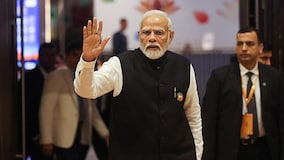How Narendra Modi is leading from the front

Prime Minister Narendra Modi. PTI
We firmly believe that credit should be given whenever and wherever it is due.
Successful completion of G-20 summit and consensus on Delhi Declaration will have far reaching global impact and on India’s present and future leadership roles. The success of Chandrayaan 3 Mission had already added to India’s prestige as a leading country in space technology and a country that can deliver. Both the recent events show that if the leadership has vision, commitment and will power, greater things can be achieved.
In our childhood we used to read ‘India is a rich country inhabited by poor’. It pointed out to the failure of leadership in realising true potential of Indians. With Modi at the helm of affairs, the scenario has changed dramatically. Having worked closely with the Government and the Party; at times we felt that the Prime Minister’s initiatives were too ambitious, utopian and impossible to achieve only to later realise that nothing was impossible with an inspiring leadership committed to a cause. With the opposition being critical at every count, pulling down every ambitions, undermining all initiatives; several feats accomplished are no mean achievement.
Related Articles
The handling of Covid crisis, the story of successfully developing domestic vaccine in record time and smooth administration of 230 crore doses of vaccine to domestic population was a masterclass in administrative efficiency. Post Covid economic recovery, prudent fiscal stimulus with precise timing of each initiative, clear glide path for fiscal consolidation and successful inflation management are other feathers in the Government’s cap. The post Covid world, including US, Europe and China is reeling under economic crisis whereas India is an outlier.
The development of Digital Public Infrastructure (DPI) which is finding resonance across the world is unparalleled in modern human history. A World Bank report says that India’s financial inclusion program has squeezed 47 years of work in to six years. G20’s adoption of DPI in Delhi Declaration is clear indication of how our ancient vision of वसुधैव कुटुम्बकम (World is one family) and आनो भद्राः क्रतवोः यन्तु विश्वतः (Let noble thought come to us from every direction) are not merely philosophical statements of the past, but the Prime Minister Modi has the will and vision to implement them on the ground. His ‘Vaccine Maitri’ outreach programme for providing vaccines to the developing world and his firm approach to overcome IPR restrictions on vaccine, despite intense global pressure was commendable. Now india is offering its digital infrastructure model as a public good to the world. For the first time this type of financial inclusion program platform is being offered as public good instead of being a source for making money for few global IT giants. It is a uniquely Indian idea; packaged, crafted to the world in the present form.
It is not only public welfare programme of prime minister with the message of “one nation, one family, one future”, that attracts my attention, but also how he is propelling Indian economy. The massive investment in building domestic connectivity infrastructure and now the announcement of India-Middle East-Europe economic corridor under G20 group, will not only leverage Indian trade and investments, but will also enhance our strategic security requirements. This economic corridor is culmination of his vision and in his foresight, he negotiated with different European countries like Israel and Greece for the ports and aimed to secure trade routes through Suez canal. India-Middle East-Europe corridor is a fitting reply to China’s Build Road initiative (BRI). Under BRI one participating country after another is reeling under the burden of sovereign debt and getting into debt trap, whether it is Pakistan, Kenya or Sri Lanka. Now India has become the voice of South Asian countries and a champion for the development and integration of African nations. A large part of global population resides in the African continent and still its voice was not being heard at global platforms. India’s presidency of G20 has corrected this anomaly.
Having said the above, I am also sure that India’s global leadership will not be achieved by our philosophical and civilisational wealth alone, but when it is an economically developed nation. Ancient India was leading in varied areas such as art, music, dance, festival, food, culture, architecture, language, handicraft; when it was also an economically prosperous nation, contributing over 25% to global trade and GDP. Therefore India has to become an economic power before global leadership position can be bestowed upon it. This reality is not lost on PM Modi. His vision and commitment to strong economy is also clearly visible in the future orientation of the current year’s budget. The budget envisions building ecosystem for fintech and artificial intelligence startup, digital payment, support to block chain technology, green hydrogen initiatives, village level internet penetration, head start in 5G and 6G spectrum and research and development in defense and space technology etc.
I believe that the golden time (Amrit Kaal) for India has come. We can achieve our goal of a strong nation in a leadership role, with our focused efforts and collective resolve. Under Modi India can no longer be called ‘Bharat is a rich country inhabited by Poor’. And if the opposition wants to call it Modi Chalisa, I have no qualms in acknowledge it so.
The author is national spokesperson of BJP specifically looking after economic affairs. Views expressed in the above piece are personal and solely that of the author. They do not necessarily reflect Firstpost’s views.
Read all the Latest News, Trending News, Cricket News, Bollywood News,
India News and Entertainment News here. Follow us on Facebook, Twitter and Instagram.
Original Source


